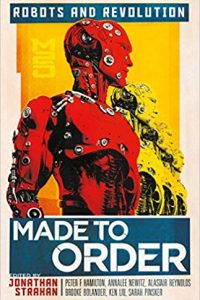Rich Horton Reviews Short Fiction: Analog, Asimov’s, and F&SF
 Analog 7-8/19
Analog 7-8/19
Asimov’s 7-8/19
F&SF 5-6/19
I’ve always thought that if Analog was truly the central bastion of hard SF among our magazines it ought to be publishing Greg Egan but, with the exception of “Beyond the Whistle Test” 30 years ago, his work has not appeared in the magazine. Until now! And “The Slipway” qualifies as pure a hard SF story as you might want – so much so that I wish he’d included some diagrams and equations! An amateur astronomer in New Zealand notices a new object, something like a star cluster, near the Southern Cross, and alerts an observatory in Australia. Dr. Fatima Benga, a Senegalese astronomer working at the observatory, takes the lead in studying this object, which seems curiouser and curiouser over time – it looks like sort of a window to the galaxy, growing larger quite swiftly. In purest SF fashion, the working out of the story is essentially the process of coming to understand what this thing – called “the Pane” – really is, and the reader is invited to indulge their sense of wonder by the end.
Ray Nayler has been consistently producing exceptional work since his magnificent first Asimov’s story, “Mutability”, appeared in 2015. His latest, “The Ocean Between the Leaves“, is another gem. Feride is a young woman living near the Istanbul Protectorate – one of the poor in the shadow of the remarkable privileged Protectorate citizens. A gardener at a rich family’s vacation estate, she is infected after a thorn prick and ends up in a coma. (The Sleeping Beauty allusion is overt.) Fahri, her brother, whom she never knew, visits her regularly, and strikes up a fitful relationship – “five-minute dates” – with one of the nurses. Fahri is a skip-tracer, a man who hunts down people who have rented “blanks” – bodies that they control remotely – and who are trying to avoid returning to their own bodies. All this is cleverly, and quite movingly, unwound in a story that is many things: a look at a complex near future, an examination of economic injustice in that future, a tale of a dying (or sleeping?) woman, and a sneaky love story. Excellent.
I was also excited to see a new story from Tegan Moore, whose “Epitome” really impressed me in Asimov’s in 2016. “The Work of Wolves” is told from the viewpoint of Sera, an enhanced, or EI, Search and Rescue dog. She, and her handler, with whom she has an uneasy relationship, are reassigned to a tricky problem, one usually delegated to military EI dogs: tracking and recovering a terrorist at a nuclear plant. The story turns on the motivations of the terrorist group, which purport to represent the rights of animals; the nature of the creature Sera is after; and most importantly, on the true desires of EI animals like Sera. The ending is ambiguous, a bit dark, appropriately asking more questions than it answers.
The issue closes with a bang-up long novella from Suzanne Palmer, “Waterlines“, an adventure set on an icy planet that humans share with aliens called the “Oceanics.” The few hundred humans on the planet must stick strictly to land and the aliens to water. Ray Landham is the outwardly cynical career bureaucrat who runs the human settlements and is stuck handling an emergency when an alien “Walker” (a giant robot carrying an Oceanic inside) approaches. He learns that the Oceanics have discovered three human corpses, mutilated in horrifying fashion. Ray has a mystery to solve, which is made much more personal and perilous when he is kidnapped and nearly murdered. The story is built on an increasing series of revelations about the true nature and history of the Oceanics, the genetically engineered slaves called Yetis that humans use and, of course, about the reason for the murders… which is more horrifying than I at first expected. It also features an affecting budding friendship between Ray and the first Oceanic he meets. The conclusion is really moving, with a striking closing twist. It’s also terrifically exciting. (I could quibble about some of the implied economics of the setup, and I thought the villains a bit overboard.)
Thanks to the machinations of the US Post Office, I didn’t get the May-June F&SF until now. It was worth the wait, though, beginning with another giant robot cover (a much different giant robot than the one for July-August or on the cover of the July-August Asimov’s). The May-June cover illustrates a strong novella from Lavie Tidhar, “New Atlantis“, told by Mai about a journey over the altered Land and dangerous Sea to New Atlantis which she made when she was young. She visits places like Tyr and La Ville Lumiere, and eventually journeys somewhere stranger – to a “civilization” inside a Vault where she has a love affair. All this is deeply science fictional: the ecologically motivated future civilization in the midst of a sort of post-apocalyptic world, the various varying malevolent machines, and the hidden virtual society, but the overlay is fantastical, and there are references – grace notes – to the Arthurian cycle, to Heinlein, to Auden, even to Alan Garner. Lovely work.
Debbie Urbanski’s “How to Kiss a Hojacki” is impressive and quite disturbing. It’s told by Michael, whose wife is one of an apparently great number of women who have changed mysteriously in a number of different ways. What matters most to Michael is that his wife doesn’t speak any more and has no interest in sex. He is probably physically incapable of same. She still claims (in writing) that she loves him. There are political repercussions – both anti-Wonderful (the more universal term for the changed) and pro-Wonderful. But this story mostly concerns Michael’s desperate attempts to deal with his wife’s change, which is a shortcoming because Michael is rather a jerk. The overall picture is quite strange and thought-provoking – I think it might have worked even better seen from a different angle, but that said, this is still a strong work.
Recommended Stories
“The Slipway”, Greg Egan (Analog 7-8/19)
“The Work of Wolves”, Tegan Moore (Asimov’s 7-8/19)
“The Ocean Between the Leaves”, Ray Nayler (Asimov’s 7-8/19)
“Waterlines”, Suzanne Palmer (Asimov’s 7-8/19)
“New Atlantis”, Lavie Tidhar (F&SF 5-6/19)
“How to Kiss a Hojacki”, Debbie Urbanski (F&SF 5-6/19)
Rich Horton works for a major aerospace company in St. Louis MO. He has published over a dozen anthologies, including the yearly series The Year’s Best Science Fiction and Fantasy from Prime Books, and he is the Reprint Editor for Lightspeed Magazine. He contributes articles and reviews on SF and SF history to numerous publications.
This review and more like it in the August 2019 issue of Locus.
 While you are here, please take a moment to support Locus with a one-time or recurring donation. We rely on reader donations to keep the magazine and site going, and would like to keep the site paywall free, but WE NEED YOUR FINANCIAL SUPPORT to continue quality coverage of the science fiction and fantasy field.
While you are here, please take a moment to support Locus with a one-time or recurring donation. We rely on reader donations to keep the magazine and site going, and would like to keep the site paywall free, but WE NEED YOUR FINANCIAL SUPPORT to continue quality coverage of the science fiction and fantasy field.








